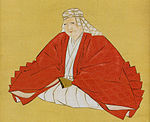Chinreisha

Chinreisha (鎮霊社, "Spirit Pacifying Shrine") is a small wooden Shinto shrine located directly south of Yasukuni Shrine's honden (main shrine) in Yasukuni Shrine precinct. It was built in 1965 after a proposition by Yasukuni's main priest, Fujimaro Tsukuba and has an annual festival held on July 13. In 1975, a steel fence was erected around the shrine and it was closed off to the public. This came after an incident on Hokkaidō a year earlier where a shrine was set on fire and after the chief priest at Yasukuni had received intelligence that unknown persons were planning to destroy the Chinreisha. It was re-opened for worshipers on October 12, 2006, to spread the spirit of cherishing allies and enemies alike and remembering all the war dead around the world.The shrine consists of two za, or seats for kami (spirits). One is devoted to all of the Japanese war-dead since 1853 that are not enshrined in Yasukuni Shrine's honden (main shrine). These kami include Japanese men who died fighting against the Imperial Japanese Army in domestic incidences such as the Boshin War. The second za is dedicated to all war dead, regardless of nationality. This is said to include, for example, even the victims affected and killed by Japan during the war. This enshrined kami in the Chinreisha stand in contrast to those enshrined in Yasukuni's honden because they include enemies of Imperial Japan, while Yasukuni Shrine's honden does not.
Excerpt from the Wikipedia article Chinreisha (License: CC BY-SA 3.0, Authors, Images).Chinreisha
Yasukuni-dori, Chiyoda
Geographical coordinates (GPS) Address Nearby Places Show on map
Geographical coordinates (GPS)
| Latitude | Longitude |
|---|---|
| N 35.693588888889 ° | E 139.74305555556 ° |
Address
靖国神社
Yasukuni-dori
102-0073 Chiyoda
Japan
Open on Google Maps










